When buying a succulent, we sometimes look for a specific shape. Perhaps to fit well with existing plants in the house, perhaps to surprise someone with our present, and perhaps just for fun :). In any case, in this article we will look at all kinds of succulents with strange shapes, resembling trees, veggies, and more. Let’s start.
Succulents that resemble palm trees
Palm trees always remind me of seaside resorts of Southern Europe. Time drags on, sun shines, people lie on the beach, and I–strolling slowly along and watching, feel at least for a short moment that world isn’t that fast-paced as everyone says. Or at least it doesn’t have to be. So why not to bring at least a memory of this feeling to colder climate, out of holiday resorts? You can grow a coconut palm indoors, but you have much better chances of succeeding with one of the succulents that resemble palm trees, and we will look at such succulents now.
Before looking at the list, I want to emphasize something: trimming and pruning always plays a big role when you try to achieve a certain shape, or a certain resemblance with your succulents. Just like you do with fruit trees in your garden, you can shape your succulents to look the way you want, for example resembling a palm tree. Keep it on your mind once you do not find the resemblance satisfactory enough.
Ponytail palm as no. 1 succulent that looks like a palm tree
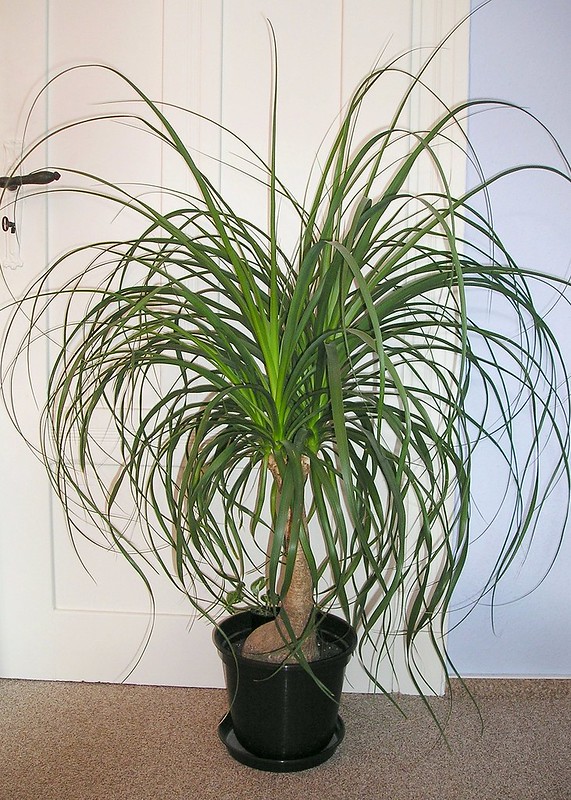
This palm has a relatively short trunk, but older ponytail palms can resemble a typical palm tree even more, once the trunk is longer…
From all succulents resembling palm trees, ponytail palm (Beaucarnea recurvata) is the one easiest to get in the US. Native to Mexico, many producers grow this beauty in greenhouses for commercial purposes. It is prone to over-watering, but other than that it doesn’t require much, thrives in neglect, and can easily live for over 50 years, even indoors. Needless to say, if you want to reach real “palm tree like” resemblance, it is better growing in outside, in a sunny spot, where some roof does not limit its growth.
What many people do not know is that ponytail palm can flower and bear fruits, if you grow male & female exemplar together, and it the conditions are fitting. The plant has also some special meaning in Feng Shui, and can bring you luck and prosperity if you place it correctly in your house. And if you believe in such stuff, of course :).
Madagascar Palm (Pachypodium lamerei) as the no. 2 succulent resembling a palm tree
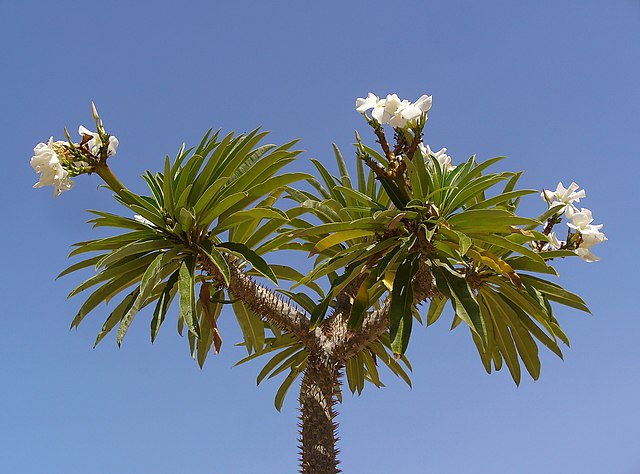
As the name suggests, this stem succulent comes from the beautiful (yet poor) isle of Madagascar, and it resembles a palm tree. It can grow quite tall outside–up to 7 meters, which is the size of many palm trees, and hence in such cases it can resemble a real palm even more than a ponytail palm does. However, it rarely reaches over 1.5 meters inside, hence you may not get the expected results should you grow it in your living room.
Many nurseries in the US grow this succulent, and it isn’t as hard to purchase as one may think, considering the origin of the plant. It requires bright light and warm temperatures, and it may wilt if you do not provide it with such. Water just enough to keep the soil from drying out completely, but remember that less is more in this case. It is rare losing a Madagascar Palm to under-watering, but pretty common to lose it to over-watering…
Chinese Fan Palm (Livistona chinensis) as no. 3 succulent that looks like a palm tree
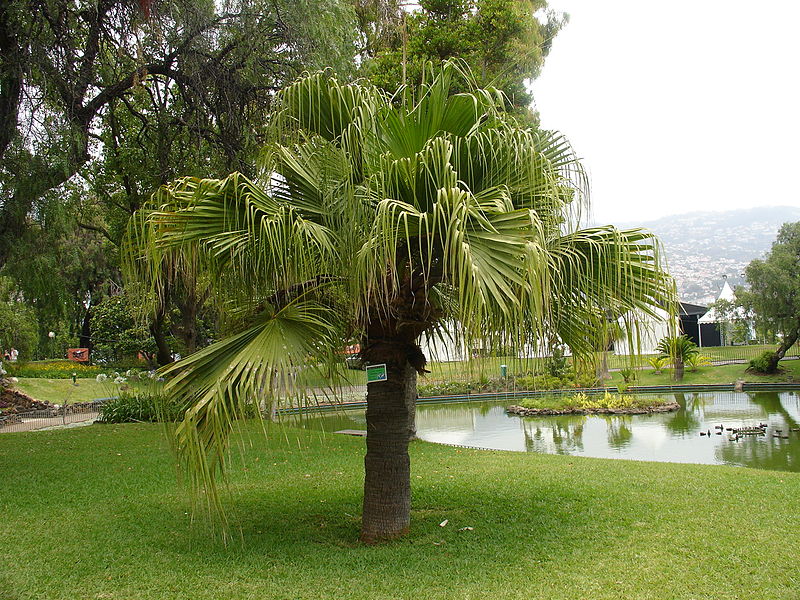
Another corner of the world, and another amazing succulent that resembles a palm tree. It s a slow-growing plant that can live for decades, and eventually grow as tall as 15-feet, resembling some smaller palm trees in both shape and size. It prefers bright indirect light and enjoys some shade. When the top of the water feels dry, water it, but do not overdo it. It can tolerate variety of soils and it is relatively easy to grow.
I hope you have found on the list your favorite succulent, and wish you best of luck with your plants!
May also interest you: Ponytail palm trunk soft – Causes & Remedies.
Succulents that look like cabbage
Cabbage is a healthy vegetable most kids do not like. But you should eat it often, especially in winter, in fermented form. Having said that, a vegetable garden isn’t the only place where you can find cabbage, or cabbage-like plants. In the versatile world of succulents, with endless shape and colors, one can find a plant resembling almost anything, including cabbage. In this post we will look at three such succulents, all of which you can grow both indoors and outdoors.
Before we look into details, I want to point out something for rabbit lovers. Rabbits do not look at plants in a way we do. They rely on different senses than humans–mostly on smell and hearing, and they can recognize a real cabbage from a succulent plant resembling one. Hence you do not have to worry that your favorite pet will devour your beautiful succulent for breakfast! That’s for the introduction, let’s move to the list.
No .1 succulent resembling cabbage: Echeveria Ruffles, or “The ornamental cabbage”
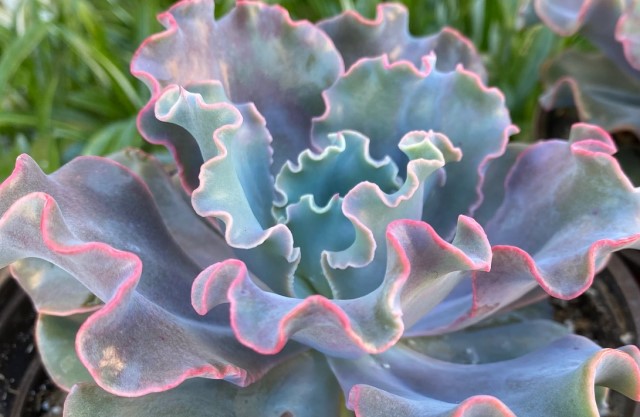
This beauty comes in many color variations, and in some of them it resembles cabbage more than any other succulent does. You can easily buy it in the US, since many producers grow it in green houses.
It isn’t particularly demanding (just like vast majority of succulents), though it enjoys brightly lit conditions and dry air. It grows fairly quickly, just like cabbage does, which may add to confusion of some of your visitors, who may inquire why you grow cabbage on your bedroom window :).
No. 2: Aeonium Smithii
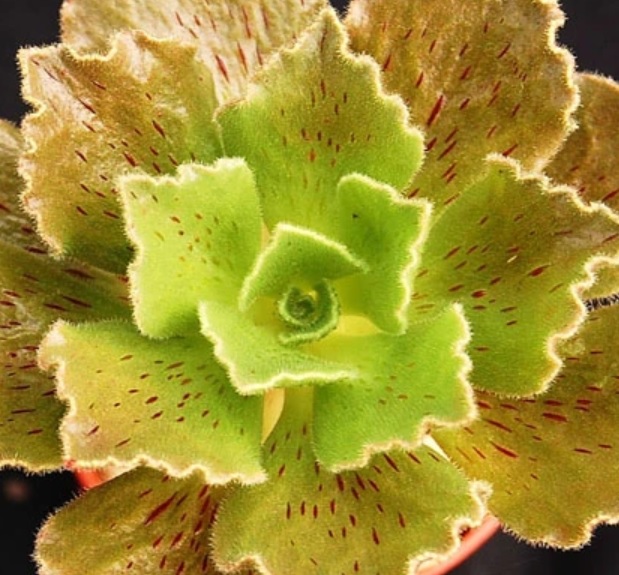
One of the many beautiful succulents native to Canary Islands (this one lives on Tenerife, on the volcano, at least 1,200 meters above sea level), this one isn’t as easy to get as the “Ornamental Cabbage” succulent. However, you can get it in some shops in both Europe and US, but get ready to pay a higher price. As you can see on the picture, it resembles cabbage from the distance. Getting closer though, you will notice the tiny hair on the leaves as well as special coloring, which easily distinguishes it from the cabbage in your garden.
You should care for it like you do for other members of aeonium family: dry conditions, taking it inside when temperatures drop below 10 degrees, and water sparingly. It doesn’t rain often on Canary islands, so you can imagine what this succulent likes. Having said that, climate and soil on the Canary Islands is really specific, and it may not surprise you that many people struggle to grow this succulent in their house or garden.
No. 3 succulent that looks like a nice cabbage: Sempervivum tectorum, the common houseleek
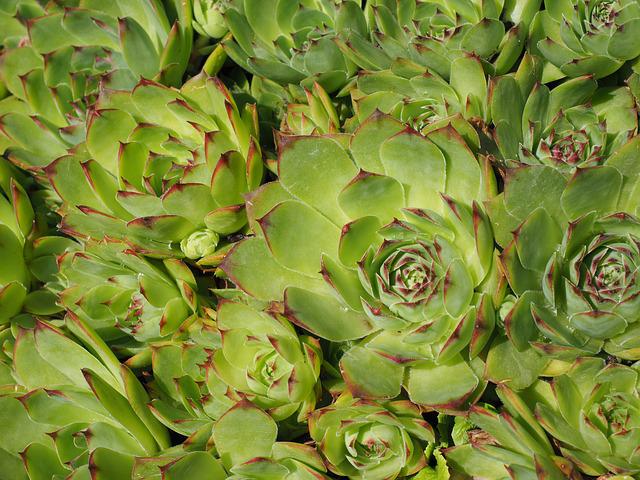
The last choice on my list may surprise you, but I have to go with one of the most commonplace succulents of all. Native to Southern Europe and cultivated all around the world, this succulent is inexpensive and easy to get. The rosette-forming evergreen succulent is easy to care for and undemanding. If you plant it in a right spot outside, that means some sunny spot in a dry climate, it will just grow and grow and you can enjoy a “garden of small succulent cabbages” in your courtyard.
In the past people believed the plant protected houses against thunderstorms, which is the main reason why they grew it on house roofs, and why it is called House Leek. Now people grow it mostly for pleasure, through in some rural parts of Italy and Spain you will still find in on many rooftops. As I’ve already said, this succulent is much easier to get than the previous two species (though they resemble cabbage better), and it can be the one you were looking for. Just visit your favorite online store, or a neighbor who grows it and will happily give you a few small rosettes.
World of succulents will never cease to fascinate me with countless colors and shapes. With over 10,000 succulent species growing in the world, you can find a plant resembling anything you could imagine, and also some things you couldn’t. Let’s have a look at another category now!
Succulents that look like trees
It may surprise you but we presently know more than 10,000 succulent species in the world. Ranging from tiny gray succulents which you may easily mistake for rocks, through robust cacti–often centuries old, to huge succulents that look like trees, and you would likely never guess they belong to this plant family. The variety is puzzling, and exciting. In my opinion, as long as we speak about decorative plants, you will find whatever you dream of with succulents. But what succulents do resemble trees?
Actually many of them do. But some are specific to the wild nature, and you cannot buy them in a shop. Some are even protected and trying to take them home could lead into a hefty fine. But we know some succulents that look like trees and you can grow them in your garden, or even in your home, should you have ample space and high ceilings (and fascination for these plants). Let’s have a look at them, one by one.
No. 1 succulent resembling a tree – Jade Plant (crassula ovata)
You may be disappointed now, If you thought I would start the list with some exotic succulent from the darkest and driest depths of Saharan desert. The exact opposite is true, and I have to start with one of the most popular succulents of all-Jade Plant.
Jade Plant, if you care well for it, can easily grow to six feet, with plenty of branches and leaves, resembling a sort of a “mini” tree, just like some dwarf trees you see in mountain areas with strong winds and colder climate. What I try to point out here though is that pruning plays a big role. If you aim for a tree-like Jade Plant, it is important to limit trimming to the minimum in the upper parts of the plant, and cutting away the branches at the bottom. Playing with it a bit, you can achieve an authentic tree look of your Jade Plant!
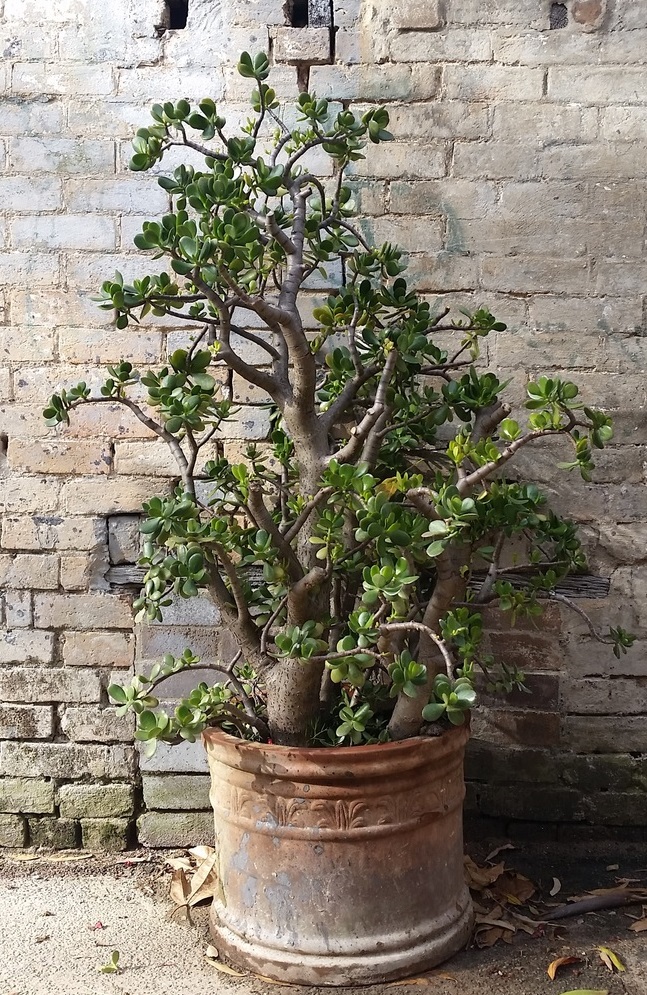
No. 2: Tree of Love (Aichryson Laxum)
This miniature succulent resembling a dwarf tree, is native to Canary Islands (one of the places that will always remain in my heart). You can find some species of this plant family also in Azores, Madeira, and Portugal, especially on wet cliffs close to the see (here goes the myth about all succulents growing in dry areas). In certain cultures, this succulents makes for a common gift to young couples after weddings, since it is believed it brings peace and love to the house (I should probably get one too :)).
Good news is that even though it isn’t a typical succulent, you won’t find it difficult to care for it. Just do as you do with other succulents, with only two differences: slightly more humidity and less direct sunshine. However, aichryson laxum is quite versatile, and it will sustain a lot. Just you may not witness it flower if you keep it in conditions which it doesn’t prefer. Tree of Love isn’t as easy to buy as Jade Plant, but you can still get it in specialized stores or online.
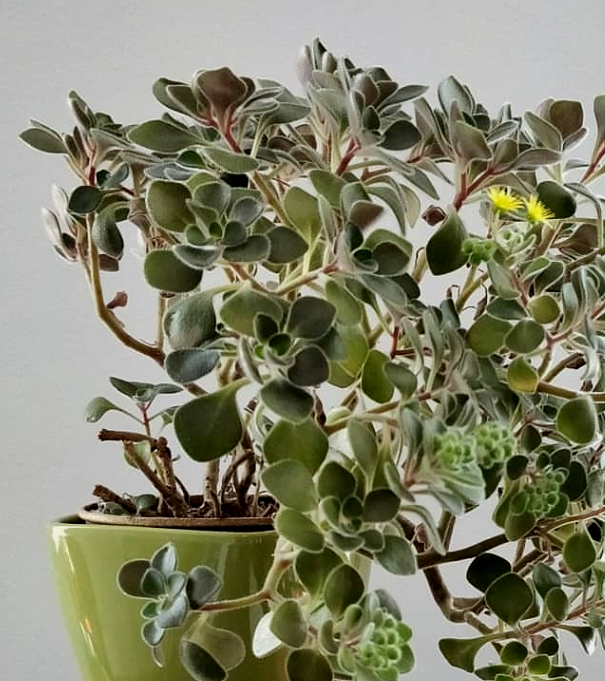
No. 3, this time resembling a pine tree: Crasssula Tetragona
This succulent, often nicknamed “mini pine tree” isn’t one of those plants that blows you away the first time you spot it. Relatively uniform in color, and small, you need to really open your eyes to appreciate its delicate beauty. Just like the name suggests, it resembles a mini pine tree. It will never grow large, hence it is ideal for indoors settings, though the succulent can thrive both indoors and outdoors.
It is mildly frost tolerant, and needs just about the same growing conditions as any “mainstream” succulent–fast draining soil, at least 4-6 hours of light per day, and infrequent watering schedule. One thing I like about this succulent is easy propagation, from stem cuttings. Hence if you like this succulent and want to gift it to your loved ones, you can grow new “mini pine trees” at home.
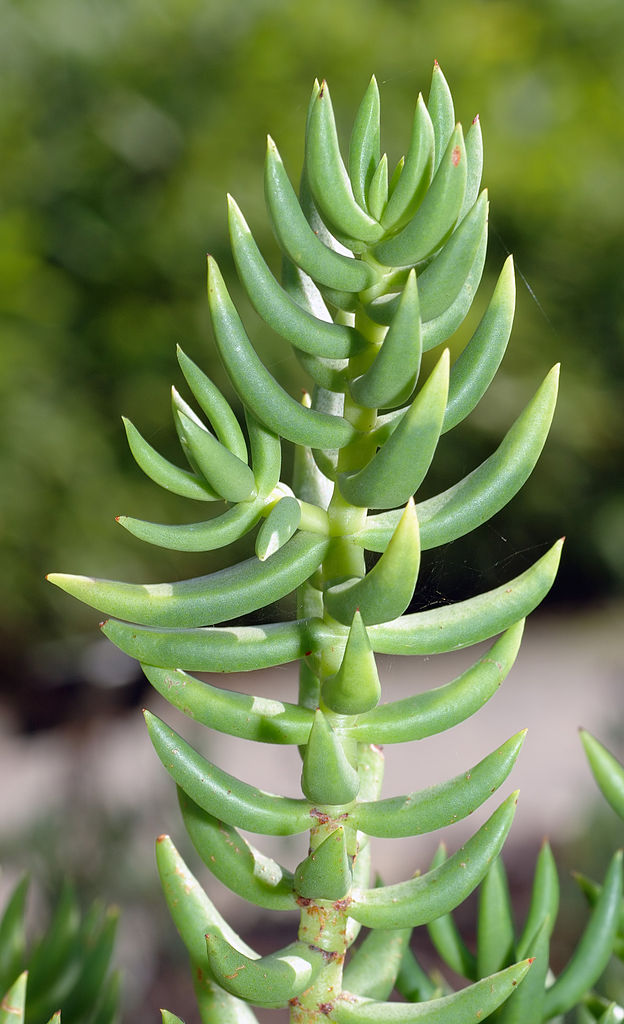
In the wast world of succulents, with a bit of imagination you can find a plant resembling almost anything, including a tree. In this post we looked at three succulents resembling trees that you can realistically get from a specialized plant shop in your city, or purchase online. Of course, you will find other succulents resembling trees, both miniature and real-life size. If my selection doesn’t satisfy your appetite, feel free to search further :).
Succulents that stay small, regardless of age
Each of us has some preferences when it comes to succulents. Some people love tall succulents that never stop growing and take lot of space in their house or garden (we’ll look at those in a little while). Others though prefer smaller plants, for one reason or another. Euphorbia Milii, for example, is low maintenance and long life succulent that can grow for a couple of inches up to several feet. On the other hand, Roseum is an example of a low-growing succulent that only gets to be about four to six inches tall. Let’s have a look at succulents that stay small, at least when compared to other succulent species.
1. Lithops – family of small succulents
Lithops are sometimes called as living stone plants or split rock plants. Lithops are little succulent plants that have almost fused leaves and a split in between where the stem is located and where the succulent flowers (once it does). Let me show you some of the estimated thirty-seven species of Lithops.
- Lithops Hookeri – This Lithops species have a leaf that can grow for about two inches wide, quite larger than any living stone plants. Hookeri’s flower usually blooms in the shade of bright yellow. The color of the upper edges of its leaves can range from brownish turns to pink or red.
- Lithops Fulviceps – This species prefers cold desert regions and rocky areas. Fulviceps’ leaf shape looks like a neat oval without a flower but will look like a kidney bean when a flower passes through its split. The edges of its leaves are found in a grayish green pigmentation also in a yellowish tone or sometimes cream-colored.
- Lithops lesliei – The Lithops lesliei is the only type that is found in its natural environment. This species matches the color of the soil that surrounds it. It rarely rises more than a couple of millimeters above the surface. Its yellow flowers can also be used for medicinal purposes.
- Lithops dorotheae – Discovered by Dorothea Huyssten, this Lithops species has a creamy pale green pigment with its leaf colored in a darker shade of green.
- Lithops viridis Also called as Green Rock Plant, Viridis is a Lithops species that is found to be uniformed in pigmentation. It has grayish pink edges, sometimes grayish green, with an upper surface of a dark grey-green tone. These split rock succulent plants can grow in size by creating two leaf pair that gradually expands and become a clump of small plants.
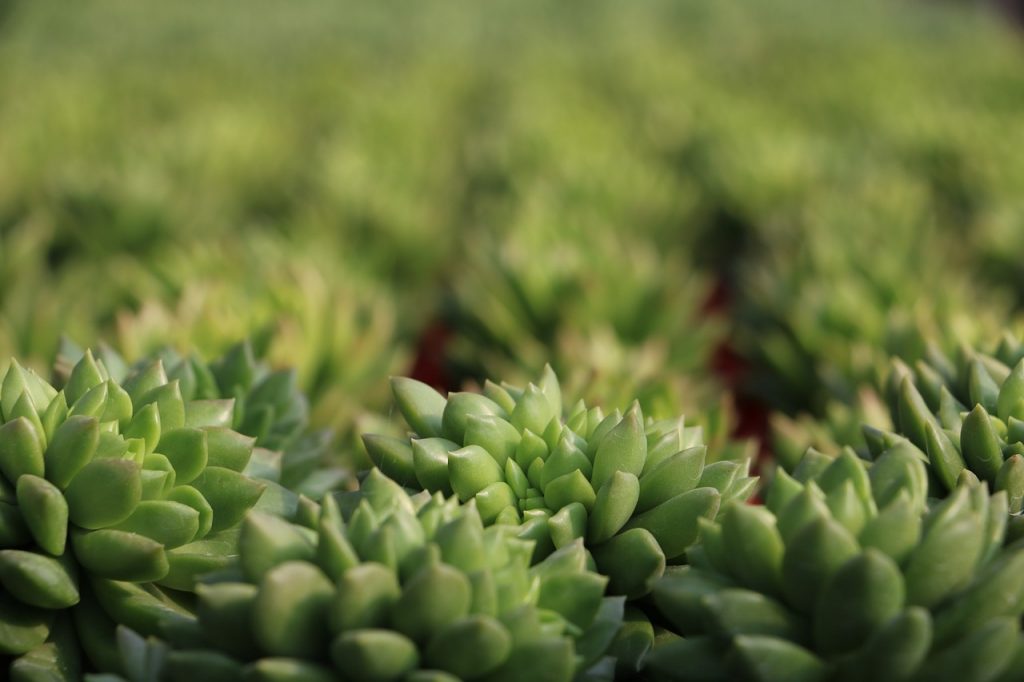
2. Lapidaria Margaretae
Lithops aren’t the only succulents that stay small. Also known as Karoo Rose, Lapidaria Margaretae is a dwarf succulent plant. It has two to four pair of leaves that could be one and a half to two cm long and one cm wide. Over a period of time, its yellow flower can get about 5cm wide. L. Margaretae is usually used as an ornamental plant that needs full bright sunlight.
3. Conophytum Calculus
Having its pair of the leaf being fused entirely, Conophytum Calculus looks like a rounded ball succulent plant. It only has a tiny split on top where its flower grows and passes through.
Conophytum calculus is a kind of succulent that is known to be stemless. Its spherical leaf body has a diameter that could be measured up to 30mm, and its body is found to be smooth and hairless. Its brown seed capsules of 3 by 5mm could be small but are found robust bearing many tiny seeds inside. So that’s to small succulents, now let’s have a look at succulent plants that grow really BIG.
Succulents that can grow really big and tall
Succulents do grow tall. But not all of them. There are types of succulents that grow taller than others. In most cases, succulents grow tall in the absence of sunlight. Succulents are light-loving plants. They need light to grow in the way they should grow naturally.
If your succulent is placed indoors, it is possible that it demands sunlight to avert further stretching, while searching for light. Seasons can also affect your growing succulents–in winter they struggle with light, and if they aren’t dormant (which is the case of many succulents in winter), they may grow even taller. But perhaps you want a succulent that grows tall. Maybe that’s what will fit best to your garden or room with high ceiling. Let’s have a look at the list!
No .1 Fishhook Barrel Cactus
This type of succulent can grow taller than you expect. It is commonly found in rocky mountainous regions. This type is abundant in Arizona, Southwestern New Mexico, limited extremes of Western Texas, Sonora, Northwest Chihuahua, and Northern Sinaloa, Mexico. You can buy it on Amazon here.
Fishbook barrel does not need “babysitting”. It is an easy plant to propagate in and around the Tucson area. It requires little attention and no special care. It is perfect for home decor and can fit in any garden setting. It has a high tolerance to both heat and cold, down to 10 degrees Fahrenheit. That’s because such are the conditions in its native land. You can propagate this cactus by seed. Size: 30 inches in diameter and 12 feet tall with a Globular shape.
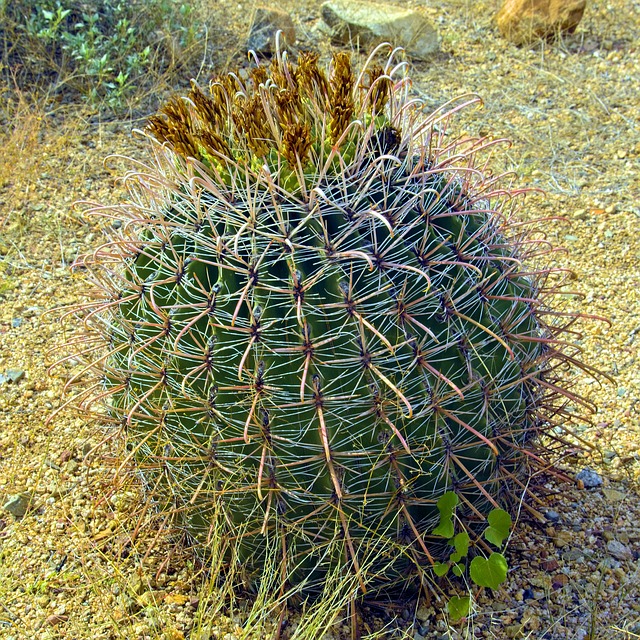
No. 2 Golden Barrel Cactus
This popular barrel cactus is known for its beautiful golden yellow spines that thickly surround the dark green to moss green body. As a common characteristic of Echinocactus, the crown or top of the stem is clothed by compact white or slightly cream-colored hair that is more striking on older and larger plants.
The Golden Barrel has quickly become one of the most commonly purchased plants for home landscape in Tucson. It is a simple plant to grow and takes no special care. Most plants are purchased at a moderately nice size and can be easily transplanted to a garden landscape or a decorative container. It is not that very fast grower but it can reach an extremely large size. Click here to get this amazing plant from Amazon.
Size: 24 inches wide and 40 inches tall with a Globular shape.
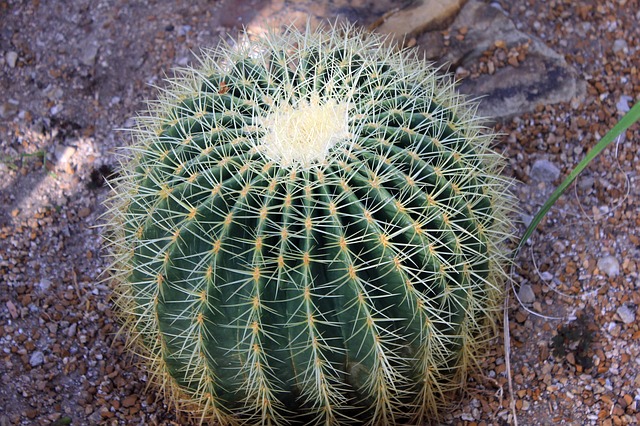
No. 3: Ocotillo
Ocotillo is a drought-tolerable shrub. It can have 6 to 100 wand-like branches that grow from the root crown. The growth rate is very slow. This pant can sustain harsh conditions. It can be dug up and transplanted later on even after many days out of the soil. To ensure good health, it is suggested to plant your Ocotillo deep enough for sufficient support and to keep the long slim stems moist with a garden hose until it is well deep-rooted.
Size: Stems can grow anywhere from 9 to 30 feet tall with spines to 1.5 inches long, spread to 15ft. It has a Clustering form. You can get this plant from Amazon.
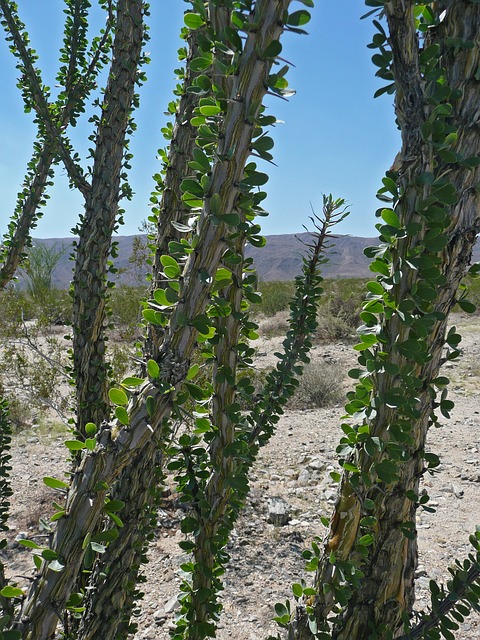
No. 4: Palmer’s Agave
This type of succulent is slightly misunderstood in that younger plants usually do not point. However, as the plant ages it will often send out many small stalk points. Characteristically, this Agave grows in areas covered by the oak woodlands from 3,000 to 6,500 ft. above limestone soils.
Agave Palmeri is a kind of slow-growing succulent that is very easy to cultivate. It can stand temperatures as low as 10 degrees Fahrenheit or lower but usually requires more humus soil than regular desert plants. The type of its propagation is by seed or rhizome offsets (stalk points). It only requires little attention and care.
Size: Medium-sized species 3.25-4 ft. and 20-47 in. wide with a Rosette shape of form.
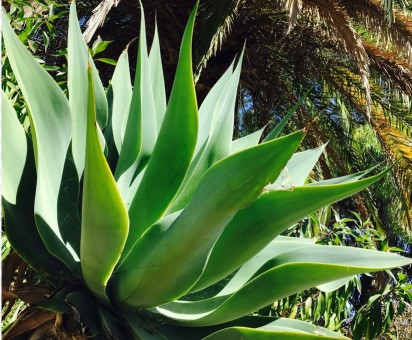
No. 5: Saguaro Cactus
The splendid Saguaro Cactus also tagged as the state flower of Arizona is composed of a tall, thick, fluted, columnar stem ranging from 18 to 24 inches in diameter, frequently with several large branches (arms) curving upward in the most typical shape of all Southwestern cacti.
Size: 35 inches wide and up to 50 feet tall with a Columnar-shaped branches
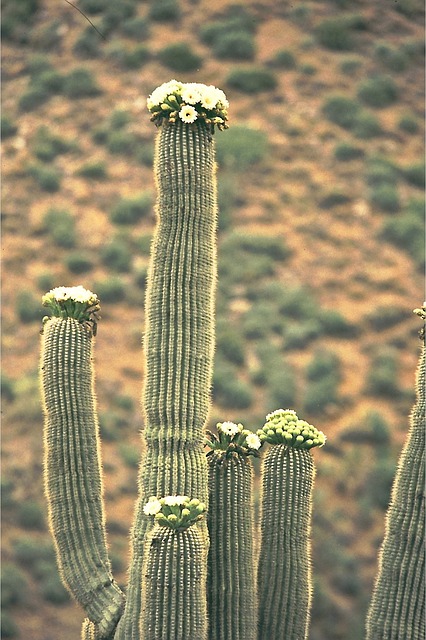
No. 6: Hedge Cactus/Queen of the Night
This plant has long columnar stems that have 5 to 7 ribs. The stems are bluish-green or dull gray-green color. Spines when present are short and brown to black in color. It is found throughout Southern Brazil and particularly in and around the city of Rio de Janeiro. You can also spot it in adjacent countries such as Argentina, Uruguay, and Paraguay.
This type of succulent has been in enculturation for many years and has been usually occupying lots of gardens. It is easy to find and to grow and has no problems adapting to any garden type. The propagation of this plant is also easy. It is by seed or by stem cuttings. You can get this plant from Amazon.
Size: 30 or more feet in height, and sometimes forming large columnar bushes.
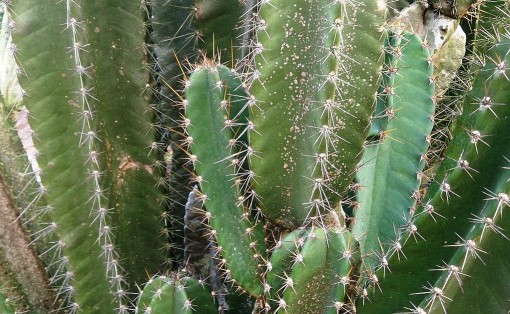
No. 7: Senita, Old Man Cactus or Whisker Cactus
The stems of the Senita are kind of bluish-green or gray-green color with white spines that will, later on, turn to a darker gray color and will form along with bristle-like display at the top portion of the plant.
The Senita is easy to grow, although it is sensitive to heavy frost or freezing conditions. It is suggested to protect the stems with a frost protective covering on very cold periods. It has a high tolerance to heat, dry conditions and needs little extra care in most garden landscapes.
Size: 20 feet in height and over 15 feet in diameter with up to 50 or more stems with Columnar stems. Flowers are seen at the upper portion of the plant and these are commonly white at the center with a pink touch at the outer ends of each petal. You can again get this plant from Amazon.
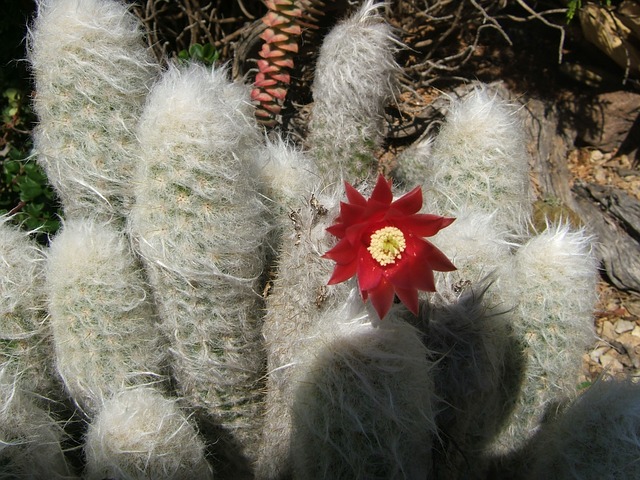
No. 8: Hedgehog Cactus
This Echinocereus type cactus is known for being abundant in arid and dry areas, and the dark brown central spine close to the top of the stem makes it easy to identify.
A very easy plant to grow in a dry-type garden. This plant is one of the native cacti and can survive with very little care. The propagation of this is by seed and offset stem cuttings. Size: 24 inches wide and 18 inches tall with a clustering shape.
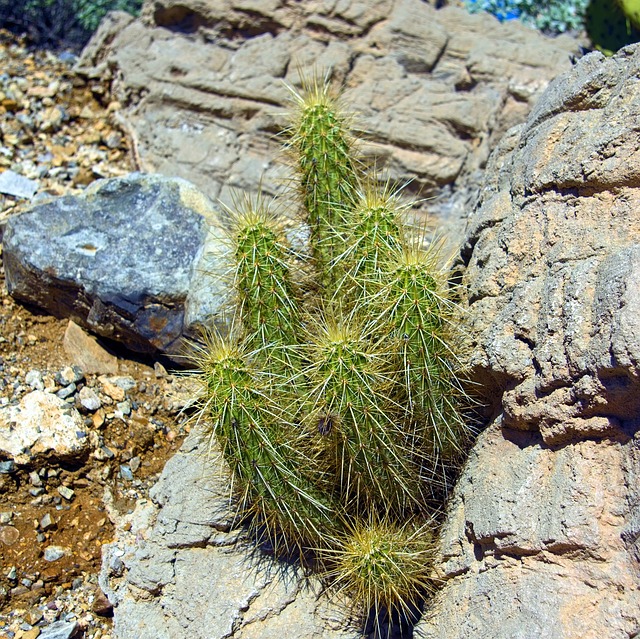
No. 9: Arizona Fishhook Cactus
This Mammillaria type cactus is very common in and around Arizona and it is known for the quite thin, short, black hooked spines. It has a magnificent beautiful pink to dark magenta flowers. It also has edible fruit. The fruit is about 1/4 to 3/4 inches long and stands out from the plant like little red chilies.
A good choice plant for a sunny patio container location or as an additional beautification to the garden. Being a local native, it is a very much carefree plant and requires a little amount of attention except for container culture. You canget this plant from Amazon, together with three other cacti, for an amazing price.
Size: 9 inches in height and 4 inches wide. Clustering plants can be much wider.
No. 10: Burbank’s Spineless Cactus
Burbank’s Spineless Cactus or the Burbank Prickly Pear can be seen by everyone driving around the cities in the Southern part of America. This plant has been in heavy cultivation for a number of years and it became readily available in some parts of Asia. It is a spineless plant with large, thick, flat joints usually about 12 to 20 inches long. Most plants have a central growing point or trunk and are sometimes extremely massive in size.
It is an extremely carefree plant for any garden type. It can be easily grown from cuttings and requires no special soil. It can take full sun as well as partial shade and it is fast to establish and grow.
Size: 15 feet in height and over 10 feet in width with Padded/Jointed shape or structure.
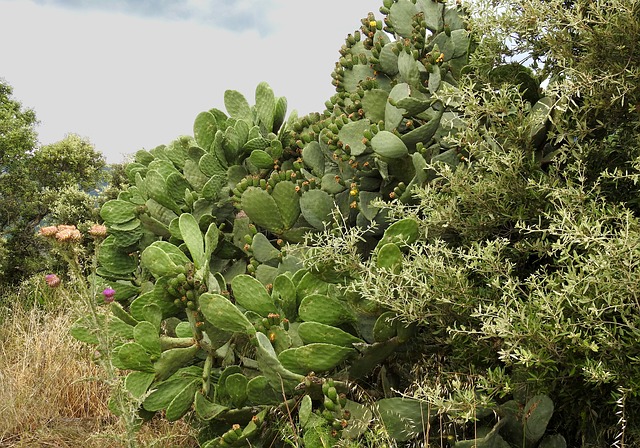
Final words
As you can see, succulents come in a huge variety of shapes, sizes, styles, and colors. It is a fascinating world of plants, where one can always, always, discover something new :). I hope this little excursion into the world of plants helped you, and that you now know what succulent you’re going to buy next.
Matthew
May also interest you:
